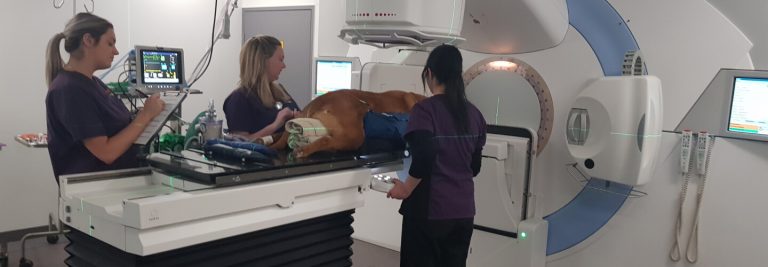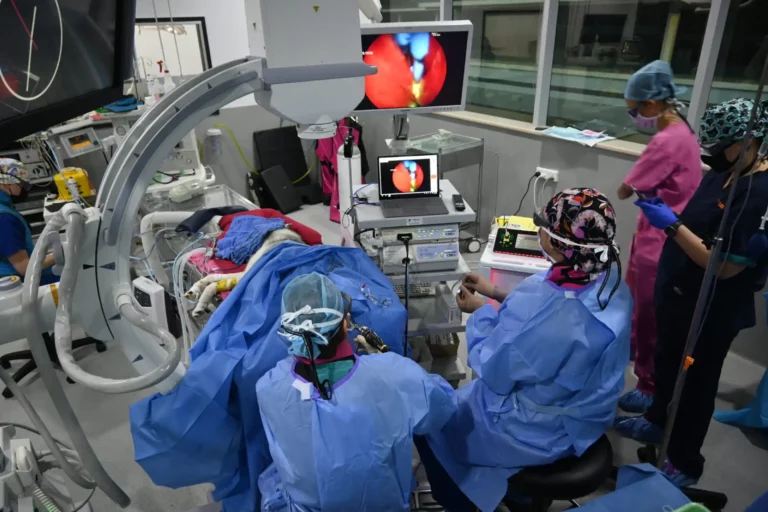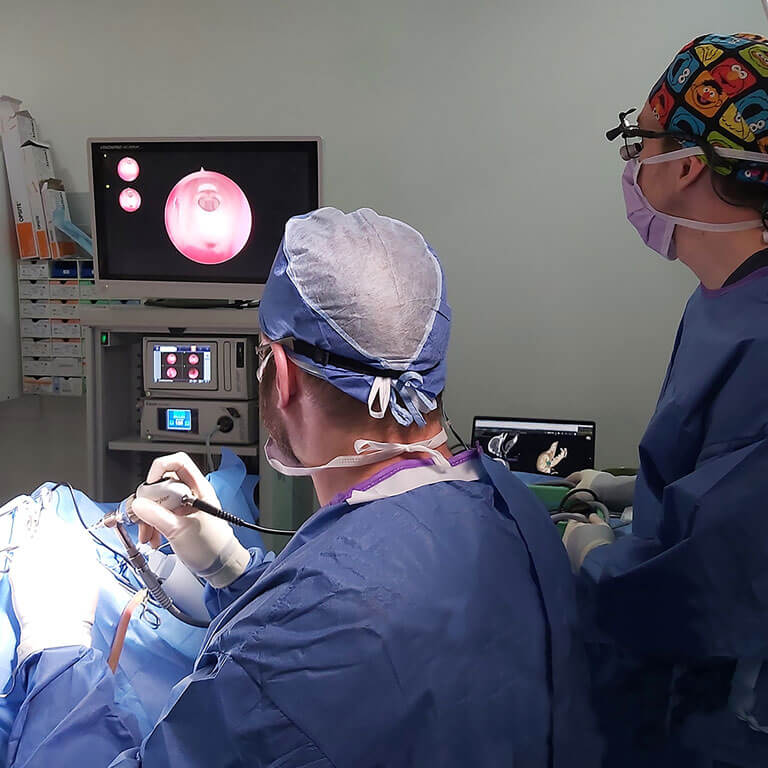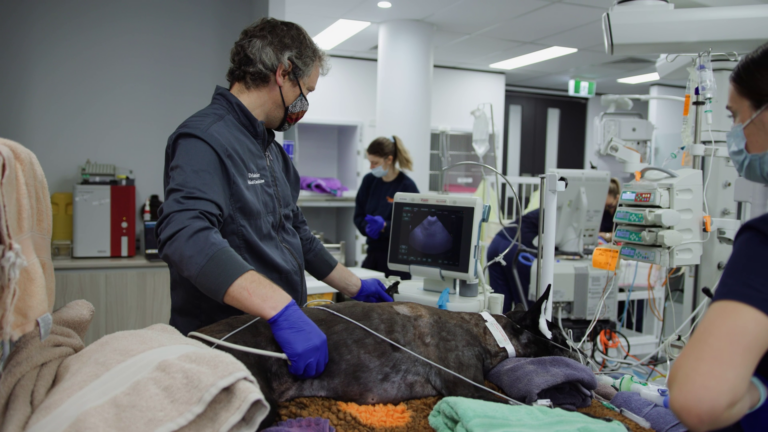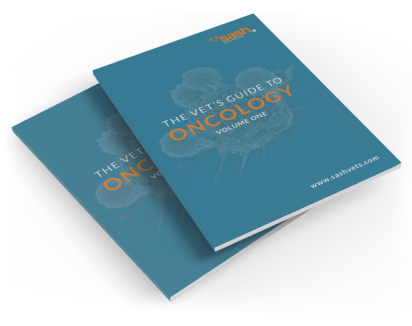TPLO Surgery Summary
- Early surgical intervention for cruciate tear is beneficial
- Arthroscopy is the least painful and most accurate way of examining and treating inside the knee joint
- TPLO is proven to be the best stabilisation treatment with several benefits over other techniques
- Outcome expectations are very good.
What is the ACL/cruciate?
The ACL or in veterinary terms, the cranial cruciate ligament (CrCL) is one of two cruciate (crossed) ligaments running through the centre of the knee between the femur and the tibia in the hindlimb. Its function is to prevent over-extension, excessive rotation and sliding of the bones relative to one another. This sliding (also called ‘cranial drawer’) is the most important function in dogs.
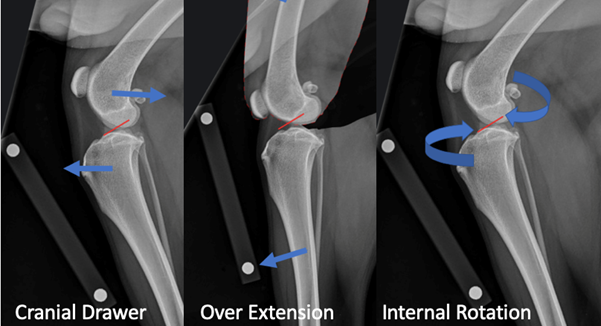
Cruciate rupture
Rupture or partial rupture or the cranial/anterior cruciate ligament (ACL) is one of the common orthopaedic conditions in dogs. It occurs in all ages and breeds but is most common in middle aged, larger dogs.
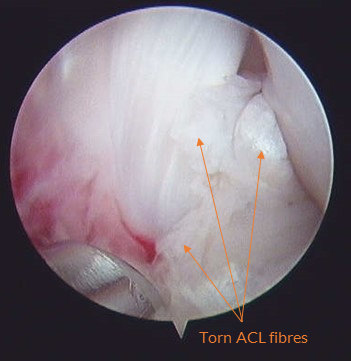
Symptoms of cruciate tears in dogs
In humans, ACL rupture is a common and sudden sporting injury. However, in dogs, the ligament tends to degenerate and undergo partial and incremental tearing over time. This leads to weeks or months of a fluctuating lameness that can respond to rest and/or pain killer medications, but with an overall worsening trend as the ligament becomes more torn. Once the ligament ruptures completely the dog will typically become more obviously lame. Joint instability often leads to tearing of a meniscus (the cartilage joint cushions between the bones), resulting in more lameness and pain.
Treating cruciate tears
The expected progression of this ‘disease’ is from partial tearing to complete rupture of the ligament, then to meniscal tear. Each progression can cause more osteoarthritis (a painful condition when the cartilage of the bone wears away) in the long term. We generally advise surgery when we suspect a partial tear. This allows the remainder of the cruciate ligament to heal. Having part of the cruciate ligament intact will prevent damage and injury to the meniscus (joint cushion) in the vast majority of patients. Early surgical intervention is preferred in nearly all dogs, with the possible exception of very small dogs who will sometimes improve without surgery.
There are various surgical techniques that can be used to repair ACL tears, but the most up to date consensus is that TPLO surgery is considered to be gold standard.
What is TPLO surgery?
Very few dogs will have their pain and lameness resolve without surgery to stabilise their knee. While several surgical treatments have been trialled over time, research regularly confirms that the most reliable and successful treatment is key-hole joint assessment via arthroscopy and tibial plateau levelling osteotomy (TPLO). Arthroscopy is less invasive than “open surgery” and allows assessment of the joint ligaments and each meniscus (joint cushion), as well as treatment of any meniscal injury. TPLO is a procedure that involves cutting of the tibia and rotating the joint surface such that there are no sliding forces, and the joint is biomechanically stable while the leg is weight bearing when walking or running.
Caring for a dog after TPLO surgery
It is important for patients to avoid any vigorous activity until the bone can be confirmed (usually with X-ray) to be healed, which is usually around eight-weeks after surgery. This means that running and jumping must be avoided. However, a program of controlled walking will be acceptable. The type of management required to control activity varies between patients and their home environments, with some dogs requiring crate or cage confinement while others can move sensibly about the house.
We advise a course of rehabilitation therapy after surgery because, just like in humans, physiotherapy increases the speed of recovery and provides the best chance for great post-operative function. Every patient receiving orthopaedic surgery (such as TPLO surgery) at SASH will receive rehab therapy at the Sports Medicine & Rehabilitation department as part of their post-operative recovery phase before discharge from hospital. We also recommend continuing rehab as an out-patient once your dog has been discharged.
TPLO surgery results
Most dogs will find it difficult to use their operated limb for one to two days after surgery. We expect them to be using it well by their first recheck around ten days after surgery, and show little to no lameness by their eight-week assessment.
TPLO surgery cost
Between now and the end of 2023, SASH hospitals are running a TPLO fundraiser for Sophie’s legacy with a fixed price offer. Please click below to find out more.
The cost of TPLO surgeries can vary greatly between different practices based on what is included as part of the surgery. At SASH, booked TPLO surgeries are performed with the following inclusions for best possible patient outcomes (inclusions may differ slightly by hospital):
- Thorough assessment & planning overseen by a Specialist Surgeon
- Anaesthesia and pain relief (including nerve block) overseen by a Specialist Anaesthetist
- TPLO surgery performed with arthroscopy (key hole surgery) for improved accuracy and reduced invasiveness
- Rehabilitation from in-house Rehabilitation Veterinarians and Therapists
- 24 hour veterinarian support to manage post-operative care, including Critical Care if necessary.
To obtain an accurate cost estimate, you will need a consult with a SASH veterinarian. However, contact us below and we can do our best to provide you with as much information as possible.
Call us for more information by clicking the contact button below.
